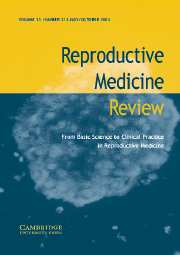Crossref Citations
This article has been cited by the following publications. This list is generated based on data provided by
Crossref.
Gullick, W.J.
and
Handyside, A.H.
1994.
Pre-implantation diagnosis of inherited predisposition to cancer.
European Journal of Cancer,
Vol. 30,
Issue. 13,
p.
2030.
Harper, Joyce C.
and
Handyside, Alan H.
1994.
The current status of preimplantation diagnosis.
Current Obstetrics & Gynaecology,
Vol. 4,
Issue. 3,
p.
143.
Liu, Jiaen
Lissens, Willy
Van Broeckhoven, Christine
Löfgren, Ann
Camus, Michel
Liebaers, Ingeborg
and
Van Steirteghem, André
1995.
Normal pregnancy after preimplantation DNA diagnosis of a dystrophin gene deletion.
Prenatal Diagnosis,
Vol. 15,
Issue. 4,
p.
351.
Rojas, Francisco J.
Garner, Chuck
Schiewe, Mitch
Asch, Ricardo H.
Balmaceda, Jose P.
and
Moretti-Rojas, Ines
1995.
Enzymatic amplification of specific deoxyribonucleic acid sequences from single cells: evaluation of a simplified and rapid method for use in preimplantation genetic diagnosis.
Fertility and Sterility,
Vol. 64,
Issue. 2,
p.
255.
Lissens, W.
Sermon, K.
Staessen, C.
Van Assche, E.
Janssenswillen, C.
Joris, H.
Van Steirteghem, A.
and
Liebaers, I.
1996.
Review: Preimplantation diagnosis of inherited disease.
Journal of Inherited Metabolic Disease,
Vol. 19,
Issue. 6,
p.
709.
Ray, Pierre F.
Winston, Robert M. L.
and
Handyside, Alan H.
1996.
Reduced allele dropout in single-cell analysis for preimplantation genetic diagnosis of cystic fibrosis.
Journal of Assisted Reproduction and Genetics,
Vol. 13,
Issue. 2,
p.
104.
Ao, Asangla
Handyside, Alan
and
Winston, Robert M.L.
1996.
Preimplantation genetic diagnosis of cystic fibrosis (ΔF508).
European Journal of Obstetrics & Gynecology and Reproductive Biology,
Vol. 65,
Issue. 1,
p.
7.
Hanson, Charles
Jakobsson, Ann‐Helene
Sjögren, Anita
Lundin, Kersti
Nilsson, Lars
Wahlström, Jan
Hardarson, Thorir
Stevic, Justina
Darnfors, Catarina
Janson, Per Olof
Wikland, Matts
and
Hamberger, Lars
2001.
Preimplantation genetic diagnosis (PGD): The Gothenburg experience.
Acta Obstetricia et Gynecologica Scandinavica,
Vol. 80,
Issue. 4,
p.
331.
Munné, Santiago
2002.
Preimplantation genetic diagnosis of numerical and structural chromosome abnormalities.
Reproductive BioMedicine Online,
Vol. 4,
Issue. 2,
p.
183.
Meschede, Dieter
and
Horst, Jürgen
2018.
In Vitro Fertilisation in the 1990s.
p.
293.
Treff, Nathan R.
2020.
Polygenic risk scoring in the human embryo: reproductive genetics, final frontier?.
F&S Science,
Vol. 1,
Issue. 1,
p.
14.


